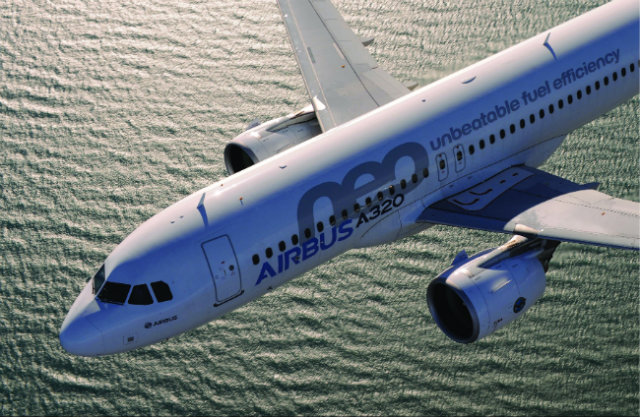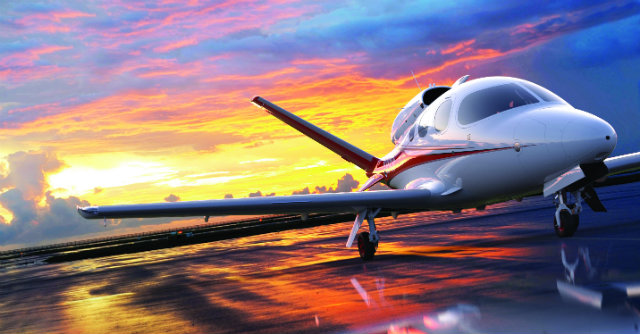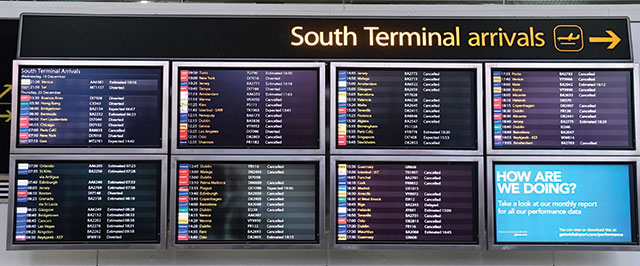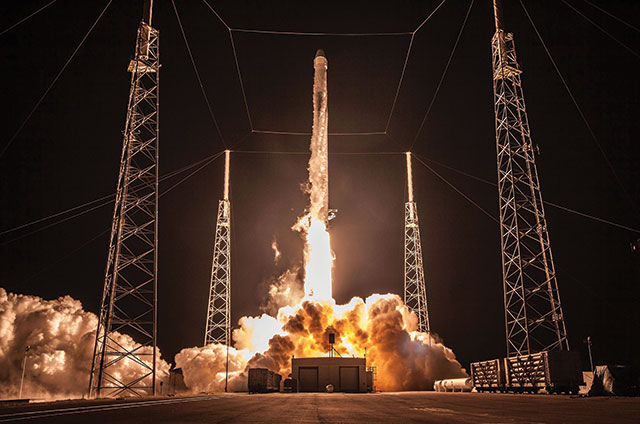Starting with magnificently moustachioed aviation adventurers and ending with an industry that continues to shrink the planet, a lot happened in Flight International’s first 100 years. However, what have been the biggest developments since we celebrated our centenary in 2009? From the promise of electric propulsion to the rise of commercial spaceflight, and re-engined airliners to the emergence of China as an aerospace power, we list 10 paradigm-shifting trends from the first 10 years of our second century.
POWER REGENERATION
After the launch of the Airbus A380 and A350 XWB, the Boeing 787, and Bombardier's CSeries in the 2000s – each of them ambitious, clean-sheet programmes – there was much speculation about whether the big two airframers would follow up with new-generation narrowbodies during the second decade of the century.
Instead, in 2010, Airbus confirmed that it would be launching a "new engine option" version of its top-selling A320 range, incorporating a version of the geared turbofan engine from Pratt & Whitney chosen to power the CSeries, or a development of CFM International's CFM56, dubbed the Leap. Boeing responded with the launch of its re-engined 737 Max, this time keeping CFM as sole propulsion partner.
Meanwhile, Embraer chose another version of the P&W engine for the E2 evolution of its successful E-Jet range and pulled well clear of rival Bombardier in the order stakes for regional and small narrowbody jets.
The re-engining craze continued in widebodies, with Airbus announcing a Neo version of its A330, with new Rolls-Royce Trent 7000 engines, while Boeing was a bit more adventurous with the structural design of the re-engined 777X, although it essentially stuck with its winning formula in the long-range, large-cabin widebody segment.
In single-aisle airliners, at least, the move has paid off. Airbus and Boeing have tapped into a surging demand for short- and mediuim-haul air travel and are moving to record output numbers. At the same time, they avoided the crippling costs and programme delay risk of designing all-new aircraft, leaving most of the heavy lifting to their engine suppliers.
The cycle may be about to switch again though. Boeing is working on its all-new new mid-market airplane, a medium-haul airliner, while the 2020s could see Airbus and Boeing work towards successors for the Neo and Max, perhaps incorporating composite wings and other structural innovations.

Airbus A320neo
Airbus
BOOM TIME FOR SUPERSONICS
No sooner had the distinctive roar of Concorde's Olympus engines died away for the last time in 2003 than noises were being made about resurrecting supersonic air travel – frivolously among dreamers who wanted to fund continued production of the pioneering airliner, but more seriously in the business jet market, through a US start-up called Aerion.
Only in recent years have the developer's ambitions – and those of at least two other would-be faster-than-sound visionaries – begun to take shape. In 2018, Aerion announced a timeline for the first flight of a remodelled AS2, powered by a new engine from GE Aviation, tellingly in 2023, 20 years after the final flight of Concorde.
Another venture, Boom Technology, plans to fly a Mach 2.2 demonstrator in 2019, with a 55-seat airliner set to enter service in 2025. A third, Spike Aerospace, is seeking investment to build its M1.6 S-512. All three have some daunting barriers to break, not least on the technological side, but also in terms of building a business case.
All of them, including Aerion, which is furthest along the road, will need to raise billions of dollars to design and build prototypes before certificating and industrialising any aircraft programme. They will also need many dozens of customers to pay an extensive premium over the price of a conventional business jet to fly faster than sound. That said, the fact that supersonic travel is being talked about seriously in 2019 is a significant development of the past decade.

Aerion AS2 640
Aerion
CHINA FLEXES INDUSTRIAL MUSCLE
China and the rest of Asia remain as important to the aircraft manufacturers today as they were when we celebrated our centenary, with around a one-third share of the global airliner backlog. What the past decade has seen, however, is the arrival of China as a serious power in the aerospace industry, both with indigenous programmes and as an investor in established Western companies.
Since 2011, when AVIC subsidiary CAIGA bought US general aviation brand Cirrus, Chinese companies have acquired around a dozen major European and North American companies, ranging from Austrian trainer aircraft manufacturer Diamond to Swiss maintenance, repair and overhaul house SR Technics, to Northern Ireland-based Thompson Aero Seating.
At the same time, after dipping their toes in the water of local assembly and low-value supply chain involvement, the Chinese have been fast developing their industry at home. Comac launched in 2008 specifically to develop a competitor to the latest versions of the Airbus A320 and Boeing 737, the C919.
The state-controlled group also inherited from AVIC the troubled ARJ21 regional jet programme, which finally entered service in 2016, eight years after first flight. However, most believe the modestly selling ARJ21 is a dry run for China's much bigger ambitions, both with the CFM International Leap-1C-powered C919 – which flew in 2017 and is due to enter service by 2021 – and the planned CR929 widebody, a joint project with Russia.
So far, China has presented little commercial threat to the established Western airframers, while providing a ready market for their products. However, with entry into service of the C919, that will surely come. With rising trade tensions between the USA and Beijing, the question for the West in the 2020s will be whether it sees China as a customer, rival or partner – or perhaps all three.

Comac-C919
Imagine China/REX/Shutterstock
GET PRINTING
3D printing or additive layer manufacturing (ALM) was invented earlier than 2009 – in fact, the first 3D printers appeared in the 1980s. However, this has been the decade where the technology has begun to make its mark on aerospace, particularly in engines. Initially, a convenient way of rapid prototyping, ALM is evolving into a technique for manufacturing an increasing range of parts, including load bearing and hot section components.
GE Aviation made a significant move in this area when in 2012 it bought a pioneer of 3D printing – Morris Technologies, conveniently based in its home city of Cincinnati – and since then has been the pioneer in the sector. In November, GE received regulatory approval to use an ALM part in a GEnx-2B engine, its third powerplant to incorporate the technology after the CFM Leap and the GE90. In late 2018, the propulsion specialist said that up to one-third of its general aviation Catalyst engine – set to power the Textron Aviation Cessna Denali – would be produced using ALM processes.
GE's Italian Avio Aero subsidiary has also been a leader in the technology, and other engine manufacturers have got in on the act. In 2015, R-R flew a Trent XWB-97, using what it said was the largest component produced with ALM, a front bearing housing. Meanwhile, aerostructures manufacturers, including Airbus subsidiary Premium Aerotec, have spoken of investing heavily in 3D printing. The true age of ALM may not arrive before the 2030s or beyond, but the decade from 2009-2018 was when its potential really began to be recognised.
FAREWELL TO THE VLJ
The global financial crisis, the onset of which coincided with Flight International’s centenary, claimed many victims. One of them was very light jets, which went from a sector with up to a dozen players in 2008 – promising a revolution in personal air transportation and air taxis – to a tiny handful of survivors a decade later.
Many of the designs disappeared along with their developer – the VisionAire Vantage and the Adam A700 were just two. Others were dropped as their manufacturer moved onto other things, including the Cessna Mustang, Diamond D-Jet and Piper Altaire. Of the single-engine contenders, only the Cirrus VisionJet has made it to certification, although the slightly larger HondaJet and Embraer Phenom 100 have also been successful.
The Eclipse 500 entry-level twinjet – which once boasted thousands of orders, including from Florida air taxi pioneer DayJet (which pioneered many of the online booking techniques later adopted by Uber) and also won the Collier Trophy – survives as the Eclipse 550, although its manufacturer, ONE Aviation is in Chapter 11 bankruptcy. In the 2000s, there were worries that the low price point of many of these jets – under $2 million in many cases – would encourage thousands of enthusiasts to take to the air in aircraft they were not sufficiently trained to handle. That prediction, at least, has not come true.

Cirrus VisionJet
Cirrus Aircraft
ELECTRIC DREAMS
It may remain an unproved technology when it comes to its potential to displace or even complement the gas turbine engine, but electric power generation has become a big talking point in the past decade, and especially in the past two years. Companies from EasyJet to R-R, and Siemens to United Technologies have been working on projects to develop a wholly or hybrid electric engine capable of powering a passenger aircraft.
Mike Mekhiche, R-R global electrical head, remarks: "It’s not a matter of if, it's a matter of when. The entire aerospace business is going to be electrified." Initiatives include EasyJet and Wright Electric's plan to develop an electric-powered narrowbody passenger jet capable of flying from London to Amsterdam, and Boeing-backed Zunum Aero's partnership with Safran Helicopter Engines to design a turboshaft engine able to generate enough electric power to fly a 12-seat rotorcraft.
Uber Elevate, a division of the ride-sharing business, believes electric-powered urban air taxis could be operating as early as 2023 and UK start-up Samad Aerospace announced in early 2018 that it is designing a six-seat, hybrid-electric vertical take-off and landing aircraft that it wants to bring to market by 2022.
Israel Aerospace Industries revealed plans to fly a prototype all-electric aircraft about the size of a Textron Aviation Beechcraft King Air 350 around 2021, while United Technologies said at last July's Farnborough air show that it, too, is working on a hybrid-electric demonstrator programme.
The next 10 years could see if any of these projects become commercial realities.
CONSOLIDATION CONTINUES
Every 10 years, a spate of mergers, acquisitions and rebrands changes the landscape of the industry. In the 1990s, it was the Boeing-McDonnell Douglas merger and the consolidation after the "last supper" that saw 15 US Cold War defence giants become five. The 2000s witnessed the creation in Europe of BAE Systems, EADS, MBDA Safran and Thales.
In the past 10 years, United Technologies has become the dominant tier one supplier in the industry after adding Goodrich and then Rockwell Collins, while on the other side of the Atlantic there were rebrands for EADS, Finmeccanica and Safran's divisions. The takeover of the Bombardier CSeries programme by Airbus and Boeing's move to take a controlling stake in Embraer's commercial aircraft business has seen four major Western airframers effectively become two. Other brands that have disappeared in the past decade through acquisition include B/E, Fokker, Socata, Vought and Zodiac.
LAST OF THE MANNED FIGHTER JETS?
The venerable Lockheed Martin F-16 may have more foreign customers, but Lockheed's F-35 is the most international fighter aircraft programme ever, as well as the most expensive. After defeating rival Boeing to win the contract to design the Joint Strike Fighter in 2001, Lockheed went on to develop the fighter with at least eight customer nations, whose industries contributed to the programme.
The three versions of the F-35 went into service with the US Marine Corps, US Air Force and US Navy in 2015, 2016 and 2018, respectively. The programme has a projected service life running until 2070. That has led some to speculate that the F-35 may be the last Western manned fighter type to enter service. However, Europe may have the last word on that, with plans for Airbus Defence & Space and Dassault to co-operate on the Future Combat Air System that will replace the Eurofighter and Rafale in the German and French air forces from about 2040.
At last July's Farnborough air show, the UK unveiled, through BAE Systems, its own future fighter concept, named Tempest. What remains to be seen is whether the European heavyweights – together with possibly Italy and Spain – end up combining their efforts after the UK's departure from the EU.
Meanwhile, while US (and Israeli) companies have since the 1990s been developing highly advanced armed unmanned reconnaissance aircraft, able to attack targets with precision, stealth fighter aircraft piloted remotely or by artificial intelligence are still at the concept stage.

F-35
Darren-Pateman/EPA_EFE/Re/Shutterstock
AGE OF THE DRONE
The campaigns in Afghanistan and Iraq saw the military unmanned air vehicle (UAV) come to prominence. For the past 10 years it has been largely the turn of the commercial so-called drone, with a flurry of mainly lightweight platforms arriving on the market offering to carry out a variety of missions from delivering pizzas to film-making to aerial surveillance.
Brands such as Domino's and Amazon have conducted high-profile delivery trials, and drones that can be equipped with cameras or video equipment are available to private individuals or small businesses for as little as a few thousand dollars. Tens of thousands are sold every year.
The big barrier to the technology becoming fully commercialised in sectors such as cargo delivery or search and rescue remains that they are banned from operating beyond visual line of sight in most regulated airspace. Many in the industry also fear that there is little to safeguard against drone-owners flying them illegally in sensitive areas such as around airports.
In August 2018, a remote-controlled aircraft flying at more than 20 times the permitted altitude of 400ft came within 15m (50ft) of a Boeing 737 on approach to London Stansted airport, in just one of many airprox incidents involving small UAVs in recent years.
In December 2018, repeated drone sightings forced London's Gatwick airport to shut for a day, causing chaos to holiday travel. Although airport operators and security authorities have been making efforts to bring drone-countering technology into operation, many fear a collision resulting in a serious accident is inevitable.

Facundo-Arrizabalaga/EPA-EFE/Rex/Shutterstock
THE NEW SPACE RACE
No sector of the aerospace business has changed as much in the decade just gone as spaceflight. Technically, launching rockets remains the domain of hard-core scientists and engineers with a legitimate fear of catastrophic failure. However, their commercial environment has been through a revolution.
Flight International published its centenary issue barely three months after a company called SpaceX put a liquid fuel rocket into orbit – a first for privately developed hardware. Half a year later, that same Falcon 1 design orbited a satellite; in July 2010 came the now-familiar Falcon 9 – a cluster of Falcon 1s.
Since then, contracts have flowed in, disrupting the launch scene. The basic SpaceX rocket design is conservative, robust and could have come from any of its established rivals. But Paypal billionaire Elon Musk outflanked everybody by exploiting three critical insights.
Firstly, NASA was by the early 2000s eager to outsource launches, so government money was available – at one point SpaceX had seen well in excess of $400 million. Secondly, established launchers were Cold War legacies; that is, built by organisations designed not for cost efficiency but to achieve superlative performance while spending tax dollars in as many US Congressional districts as possible. Musk had the huge cost advantage of starting from scratch, using widely available technology, engineers trained in government-funded programmes and a streamlined supply chain. Finally, fuel is cheap but rockets are expensive. That is, Musk understood that if Falcon rockets were designed to be recovered, refurbished and re-used, they would be heavy and fuel-thirsty but, on balance, his streamlined industrial structure could sustain a higher launch rate at a lower net cost.
With lower-cost launches and more flights on the manifest, government and private customers have better access to space than ever. All rivals are responding with a new generation of hardware; a new space race is on.
Additional reporting by Dan Thisdell

SpaceX launch
Planet Pix via Zuma Wire/REX/Shutterstock
Source: Flight International






















